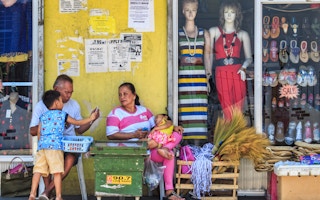With Christmas fast approaching, Mindalyn Villanueva is counting the days until she can buy essentials with food stamps she receives as part of a new programme to help some of the Philippines’ poorest families.
“I can buy rice, noodles and bread. At least for a few days, we don’t have to worry about food,” said the 43-year-old mother-of-three who lives in Tondo, one of the poorest areas of the capital, Manila.
Villanueva was among 3,000 families selected in July for a six-month pilot of the national food stamp programme. Each received 3,000 Philippine pesos (US$54) of credit per month to buy vegetables, rice, meat and other staples from partner stores.
About one in 10 Filipinos suffers from food insecurity, according to the World Food Programme (WFP), and President Ferdinand Marcos Jr. has made food stamps his flagship policy to reduce hunger among the poorest 1 million households, or roughly 6.5 million people, by 2027.
The Department of Social Welfare and Development (DSWD) aims to have the first 300,000 households enrolled in the programme receive food stamps before Christmas, funded by US$3 million from the Asian Development Bank and US$34 million of government money.
“Poverty is a big problem here in the Philippines. But there are low-hanging fruits out there that we can address to reduce poverty. One of which is hunger,” DSWD Assistant Secretary Baldr Bringas told Context.
Rising food costs have fuelled inflation in the Philippines in recent years, and Bringas said the Covid-19 pandemic had pushed more families into food insecurity.
“Government resources are very limited, so we must ensure that the assistance goes to the proper people,” he said, adding that the programme did more than simply hand out cash.
“
Poverty is a big problem here in the Philippines. But there are low-hanging fruits out there that we can address to reduce poverty. One of which is hunger.
Baldr Bringas, assistant secretary, Department of Social Welfare and Development
“We teach our beneficiaries how to prepare affordable, delicious, and nutritious food. At the same time, we also require them to attend employment promotions,” he said.
More, better jobs needed
But critics say the food stamp programme will not be enough to combat poverty and hunger in the country of 114 million people, saying structural reforms - not aid handouts - are the way to tackle entrenched poverty.
“Its magnitude does not address the risk of hunger of tens of millions of Filipino families,” said Sonny Africa, executive director of IBON Foundation, a non-profit research group.
“Poverty persists, not because there are not enough welfare programmes, it’s because the economy is not creating enough jobs and incomes for most Filipinos,” he said.
Overall, the Philippines economy has performed well, growing 7.6 per cent last year and 5.7 per cent in 2021, according to the World Bank, and poverty rates have fallen in recent years.
Unemployment is also low, at about 4 per cent, according to the Philippine Statistics Authority, but about 40 per cent of people work informally, meaning they are less likely to have access to social protection and are more at risk during a crisis.
Many countries have experimented with various forms of food stamps, and similar schemes are in use from Chile to Mongolia.

















